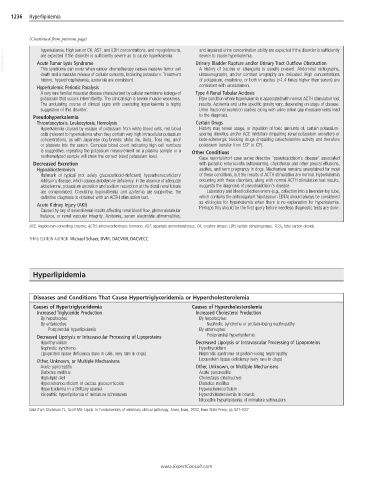Page 2484 - Cote clinical veterinary advisor dogs and cats 4th
P. 2484
1236 Hyperlipidemia
(Continued from previous page)
and impaired urine concentration ability are expected if the disorder is sufficiently
hyperkalemia. High serum CK, AST, and LDH concentrations, and myoglobinuria,
VetBooks.ir Acute Tumor Lysis Syndrome Urinary Bladder Rupture and/or Urinary Tract Outflow Obstruction
are expected if the disorder is sufficiently severe as to cause hyperkalemia.
severe to cause hyperkalemia.
This syndrome can occur when cancer chemotherapy causes massive tumor cell
death and a massive release of cellular contents, including potassium. Treatment A history of trauma or stranguria is usually present. Abdominal radiographs,
ultrasonography, and/or contrast urography are indicated. High concentrations
history, hyperphosphatemia, azotemia are consistent. of potassium, creatinine, or both in ascites (>1.4 times higher than serum) are
Hyperkalemic Periodic Paralysis consistent with uroabdomen.
A very rare familial muscular disease characterized by cellular membrane leakage of Type 4 Renal Tubular Acidosis
potassium that occurs intermittently. The clinical sign is severe muscle weakness. Rare condition where hyperkalemia is associated with normal ACTH stimulation test
The undulating course of clinical signs with coexisting hyperkalemia is highly results. Azotemia and urine specific gravity vary, depending on stage of disease.
suggestive of this disorder. Urine fractional excretion studies along with urine anion gap measurements lead
Pseudohyperkalemia to the diagnosis.
Thrombocytosis, Leukocytosis, Hemolysis Certain Drugs
Hyperkalemia caused by escape of potassium from white blood cells, red blood History may reveal usage, or ingestion of toxic amounts of, certain potassium-
cells (relevant to hyperkalemia when they contain very high intracellular potassium sparing diuretics and/or ACE inhibitors (impairing renal potassium excretion) or
concentrations, as with Japanese dog breeds: shiba inu, Akita, Tosa inu), and/ beta-adrenergic blocking drugs (impairing catecholamine activity and therefore
or platelets into the serum. Complete blood count indicating high cell numbers potassium transfer from ECF to ICF).
is suggestive; repeating the potassium measurement on a plasma sample or a Other Conditions
nonhemolyzed sample will show the correct blood potassium level. Case reports/short case series describe “pseudoaddison’s disease” associated
Decreased Excretion with parasitic enterocolitis (whipworms), chylothorax and other pleural effusions,
Hypoaldosteronism ascites, and term pregnancy in dogs. Mechanism remains unexplained for most
Hallmark of typical (not solely glucocorticoid-deficient) hypoadrenocorticism/ of these conditions, but the results of ACTH stimulation are normal. Hyperkalemia
Addison’s disease, which causes aldosterone deficiency. In the absence of adequate occurring with these disorders, along with normal ACTH stimulation test results,
aldosterone, potassium excretion and sodium resorption at the distal renal tubule suggests the diagnosis of pseudoaddison’s disease.
are compromised. Coexisting hyponatremia and azotemia are supportive; the Laboratory and blood collection errors (e.g., collection into a lavender-top tube,
definitive diagnosis is obtained with an ACTH stimulation test. which contains the anticoagulant tripotassium EDTA) should always be considered
as etiologies for hyperkalemia when there is no explanation for hyperkalemia.
Acute Kidney Injury (AKI) Perhaps this should be the first query before needless diagnostic tests are done.
Caused by any of several renal insults affecting renal blood flow, glomerulotubular
balance, or renal vascular integrity. Azotemia, serum electrolyte abnormalities,
ACE, Angiotensin-converting enzyme; ACTH, adrenocorticotropic hormone; AST, aspartate aminotransferase; CK, creatine kinase; LDH, lactate dehydrogenase; TCO 2 , total carbon dioxide.
THIRD EDITION AUTHOR: Michael Schaer, DVM, DACVIM, DACVECC
Hyperlipidemia
Diseases and Conditions That Cause Hypertriglyceridemia or Hypercholesterolemia
Causes of Hypertriglyceridemia Causes of Hypercholesterolemia
Increased Triglyceride Production Increased Cholesterol Production
By hepatocytes By hepatocytes:
By enterocytes: Nephrotic syndrome or protein-losing nephropathy
Postprandial hyperlipidemia By enterocytes:
Decreased Lipolysis or Intravascular Processing of Lipoproteins Postprandial hyperlipidemia
Hypothyroidism Decreased Lipolysis or Intravascular Processing of Lipoproteins
Nephrotic syndrome Hypothyroidism
Lipoprotein lipase deficiency (rare in cats, very rare in dogs) Nephrotic syndrome or protein-losing nephropathy
Other, Unknown, or Multiple Mechanisms Lipoprotein lipase deficiency (very rare in dogs)
Acute pancreatitis Other, Unknown, or Multiple Mechanisms
Diabetes mellitus Acute pancreatitis
High-lipid diet Cholestasis (obstructive)
Hyperadrenocorticism or excess glucocorticoids Diabetes mellitus
Hyperlipidemia in a Brittany spaniel Hyperadrenocorticism
Idiopathic hyperlipidemia of miniature schnauzers Hypercholesterolemia in briards
Idiopathic hyperlipidemia of miniature schnauzers
Data from Stockham FL, Scott MA: Lipids. In Fundamentals of veterinary clinical pathology, Ames, Iowa, 2002, Iowa State Press, pp 521–537.
www.ExpertConsult.com

